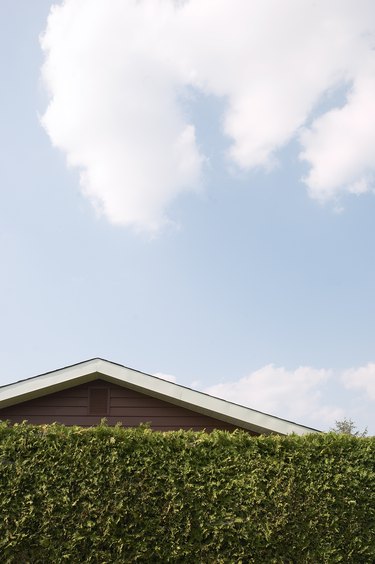
Wax leaf privet (Ligustrum japonicum) is a fast-growing shrub -- 25 inches per year -- that reaches 8 to 12 feet or taller. The shrub is hardy in United States Department of Agriculture plant hardiness zones 7 through 10, but it needs shade when planted in warmer climates. Wax leaf privet can be planted as a single specimen or used as a hedge for privacy, making use of the dense growth of the foliage.
Hedge Rows
Video of the Day
Space the wax leaf privet shrubs about 5 to 8 feet apart to grow as a privacy hedge or screen. The unpruned shrub can spread up to 25 feet across so the hedge would be very dense if left unattended. Prune the shrubs each year to keep them contained where they are planted. This close planting choice produces a living wall that can shield unsightly yard fixtures, such as a gas tank, from view.
Video of the Day
Garden Specimens
If your wax leaf privet is used as an ornamental or accent plant in the landscape, space the shrubs at least 10 feet apart. The shrubs will grow to their full potential without the need for constant pruning during the growing season. Prune the lower branches from the shrubs so they grow in more of a tree form than shrub. The wide canopy produces shade that otherwise may be lacking in your yard.
Windbreaks
Create a windbreak with a double row or staggered row planting pattern. For example, plant the first row of wax leaf privet shrubs, spacing the shrubs about 5 to 8 feet apart, and plant a second row of shrubs about 6 to 10 feet from the first row. Once the shrubs mature, the dense foliage creates a double barrier against heavy winds. The double row helps keep large pests, such as the neighbor's dog, out of the yard.
Noise Barrier
Reduce the noise of road traffic or nearby factories with a three-row planting of wax leaf privet shrubs. As with the windbreak, the rows are spaced 6 to 10 feet apart. However, you should stagger the plantings. The end result is similar to the way bowling pins are set up, with the second row planted off-center from the first and the third row planted in direct line with the first row.